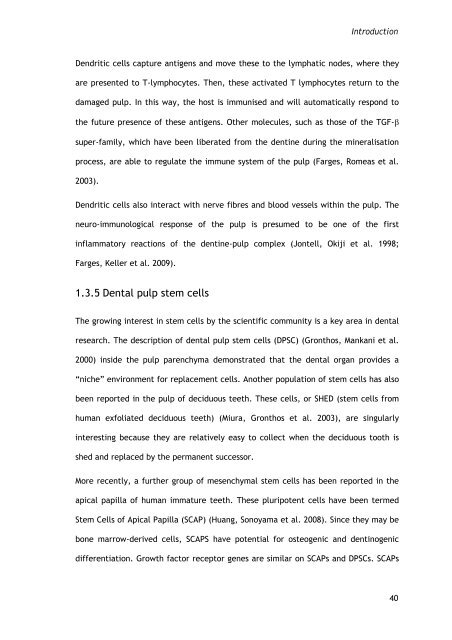Molecular characterisation of odontoblast during primary, secondary ...
Molecular characterisation of odontoblast during primary, secondary ...
Molecular characterisation of odontoblast during primary, secondary ...
You also want an ePaper? Increase the reach of your titles
YUMPU automatically turns print PDFs into web optimized ePapers that Google loves.
Introduction<br />
Dendritic cells capture antigens and move these to the lymphatic nodes, where they<br />
are presented to T-lymphocytes. Then, these activated T lymphocytes return to the<br />
damaged pulp. In this way, the host is immunised and will automatically respond to<br />
the future presence <strong>of</strong> these antigens. Other molecules, such as those <strong>of</strong> the TGF-β<br />
super-family, which have been liberated from the dentine <strong>during</strong> the mineralisation<br />
process, are able to regulate the immune system <strong>of</strong> the pulp (Farges, Romeas et al.<br />
2003).<br />
Dendritic cells also interact with nerve fibres and blood vessels within the pulp. The<br />
neuro-immunological response <strong>of</strong> the pulp is presumed to be one <strong>of</strong> the first<br />
inflammatory reactions <strong>of</strong> the dentine-pulp complex (Jontell, Okiji et al. 1998;<br />
Farges, Keller et al. 2009).<br />
1.3.5 Dental pulp stem cells<br />
The growing interest in stem cells by the scientific community is a key area in dental<br />
research. The description <strong>of</strong> dental pulp stem cells (DPSC) (Gronthos, Mankani et al.<br />
2000) inside the pulp parenchyma demonstrated that the dental organ provides a<br />
“niche” environment for replacement cells. Another population <strong>of</strong> stem cells has also<br />
been reported in the pulp <strong>of</strong> deciduous teeth. These cells, or SHED (stem cells from<br />
human exfoliated deciduous teeth) (Miura, Gronthos et al. 2003), are singularly<br />
interesting because they are relatively easy to collect when the deciduous tooth is<br />
shed and replaced by the permanent successor.<br />
More recently, a further group <strong>of</strong> mesenchymal stem cells has been reported in the<br />
apical papilla <strong>of</strong> human immature teeth. These pluripotent cells have been termed<br />
Stem Cells <strong>of</strong> Apical Papilla (SCAP) (Huang, Sonoyama et al. 2008). Since they may be<br />
bone marrow-derived cells, SCAPS have potential for osteogenic and dentinogenic<br />
differentiation. Growth factor receptor genes are similar on SCAPs and DPSCs. SCAPs<br />
40
















